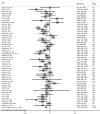The effectiveness of the use of telehealth programs in the care of individuals with hypertension and, or diabetes mellitus: systematic review and meta-analysis
- PMID: 35643495
- PMCID: PMC9148205
- DOI: 10.1186/s13098-022-00846-5
The effectiveness of the use of telehealth programs in the care of individuals with hypertension and, or diabetes mellitus: systematic review and meta-analysis
Abstract
Introduction: Diabetes Mellitus and Hypertension are some of the main Chronic Noncommunicable Diseases, representing a big challenge for global health. In this context, Telehealth programs are presented as a tool with exciting potential to complement and support health care. This paper aimed to analyze the effectiveness of the use of Telehealth programs in the care of individuals with Hypertension and/or Diabetes Mellitus.
Methods: A systematic review with meta-analysis was carried out according to the Preferred Reporting Items for Systematic Reviews and Meta-Analyses (PRISMA) protocol methodology. The following databases were used: PubMed, EMBASE, SciELO, ScienceDirect and Cochrane Library. Papers were included if they addressed the use of technologies that allow two-way communication at a distance between health professionals and patients affected by Hypertension and/or Diabetes Mellitus, type 1 or type 2. Experimental, cross-sectional, case-control, cohort, and clinical trials were included in the review.
Results: We included 164 papers in the review and 45 in the meta-analysis final synthesis. The systematic review results showed a prevalence of telemonitoring as the main form of Telehealth. The study showed a reduction in expenses with the use of Telehealth, both for the users and for the health systems providers, followed by greater satisfaction. Our meta-analysis showed that Telehealth is an effective tool in the care of diabetic patients, providing a 0.353% reduction in HbA1c compared to traditional care. No studies on Hypertension that met our eligibility criteria for inclusion in the meta-analysis were found.
Conclusions: Telehealth is an effective tool for the care of people with Diabetes Mellitus and/or Hypertension.
Keywords: Diabetes mellitus; Hypertension; Meta-analysis; Systematic review; Telehealth.
© 2022. The Author(s).
Conflict of interest statement
The authors declare that they have no conflicting interests.
Figures



References
-
- World Health Organization. The impact of The Covid-19 pandemic on noncommunicable disease resources and services: results of a rapid assessment. https://www.who.int/publications/i/item/ncds-covid-rapid-assessment. Accessed 10 Aug 2021.
-
- World Health Organization. The global diabetes compact: what you need to know. WHO. https://cdn.who.int/media/docs/default-source/country-profiles/diabetes/.... Accessed 10 Aug 2021.
-
- United Nations. Transforming Our World: The 2030 Agenda for Sustainable Development. New York, NY: United Nations. 2015.
-
- World Health Organization. Hypertension. https://www.who.int/news-room/fact-sheets/detail/hypertension. Accessed 10 Aug 2021.
Publication types
LinkOut - more resources
Full Text Sources
Miscellaneous

